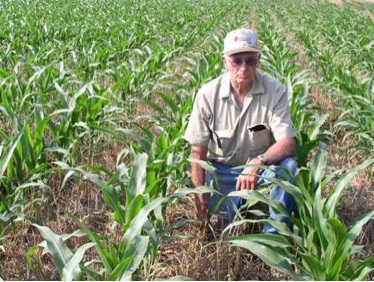Daviess County, Kentucky, farmer Myrel Trunnell, and son Kevin, farm approximately 1,200 acres in Utica, Kentucky. The Trunnell’s own four farms themselves and farm 15 other nearby farms.
Myrel was one of the first no-till farmers in Daviess County and is passing his no-till and grain farming expertise onto his son, Kevin. Myrel started no-tilling in 1970 and has been sold on no-till for 38 years.
The dominant soil on most of the cropland Myrel farms is Loring silt loam (a fine-silty, mixed, active, thermic oxyaquic fragiudalfs). Slopes are 6 to 10 percent.
 Kentucky grower Myrel Trunnell says profits have grown and soil health has improved since he started no-tilling more than three decades ago. (NRCS photo) |
He grows approximately 900 acres corn, 300 acres wheat, 300 acres double cropped soybeans, 24 acres tobacco, 20 acres sweet corn, and 8 acres vegetables and other horticulture crops (pumpkins, mums, tomatoes, squash, cantaloupe, cucumbers, green beans, and various other vegetables). All corn, wheat, soybeans, and sweet corn are no-tilled.
Myrel feels he and his family have received numerous benefits from implementing a no-tillage system. He knows his no-tillage input costs are much less than other Daviess County farmers who use tillage or minimum tillage systems. This allows him to have a higher net profit while obtaining better soil health.
He uses the time saved from implementing a no-till system to plan and implement other improvements on the land.
Myrel's goal is to leave every farm better than it was when he started farming it. To do this Myrel knows that landowners must stop performing tillage and/or minimum tillage operations and start no-tilling.
One of the numerous advantages of implementing a no-tillage system versus a conventional or minimum tillage system is the production and management of organic matter.
Organic matter and live roots are key to having, increasing, and maintaining soil health. No-tillage systems manage organic matter and plant roots for optimum soil health and protect the soil quality benefits gained from them.
Above-ground organic matter residues blanket the soil surface to protect against erosion, leaching of fertilizers, leaching of pesticides and the leaching of herbicides resulting in increased water quality.
Organic matter is the food source for microbes that build the soil nitrogen bank, enabling the soil to provide for more plant nitrogen needs. Organic matter can hold up to 90% of its weight as water, increasing soil available water holding capacity.
Myrel is concerned that landowners realize the importance of maintaining continuous no-till. Landowners who use a no-till system for several years and then till their ground, for whatever reason, need to understand they are losing soil quality gains made over years of implementing a no-tillage system.
As Myrel states, “just one year of tillage can undo five years worth of no-till benefits to the soil and completely deplete the soil nitrogen bank built up under many years of a no-tillage system.”
He plans to plant annual ryegrass due to its fast root growth and for its ability to go through and break up a compacted soil layer. He then plans to burn down his ryegrass cover crop in the spring and use a special implement to prepare strips to set tobacco. Myrel is applying one of the key components to implementing a successful no-till system, that being cover crops.
Myrel has been no-tilling since 1970, at which time he ran into several obstacles. There was very little published information about no-till and limited availability of good no-till equipment.
Since then, equipment has evolved and been developed with no-till farming in mind, enhancing the ability of landowners to successfully implement no-till systems. Myrel also had corn blight problems in the early 1970s.
Advancements in over the top chemicals to control disease, pests, and weeds as well as genetically altered seeds like roundup ready corn and soybean varieties have made no-till farming much easier and profitable.
Myrel says, “landowners who want to change from tillage systems to no-tillage systems must begin with a mindset of wanting to make no-till work on their farm. They must try it longer than just one year.
"The first year of a no-till system is a learning experience and it takes time to learn the system and all the things you need to do to obtain optimum production. You have to be dedicated to no-till, expect problems, develop innovative solutions, and make the system work for you."
Myrel encourages landowners to try it for at least 4 to 5 years. Myrel would like to see more United States statistical data published comparing no-till with conventional tillage for soil erosion, fuel, water quality, and soil quality. He believes this would give the average farmer the incentive to convert from tillage systems to a no-till system.
The biggest concern Myrel has for the sustainability of no-till systems are the future development of new chemicals to combat disease, pest, and weed control. Myrel says, “we can’t become complacent when dealing with disease, pest, and weed issues.”
Myrel is a very innovative landowner who is eager to apply new technology on the land. He has attended the annual National No-Tillage Conference sponsored by No-Till Farmer magazine for the past 13 to 14 years.
Myrel does an excellent job of applying conservation practices on the land. Since 2001, he has been involved in 10 Environmental Quality Incentive Program (EQIP) contracts — 1 on his own farm, plus 9 other farms which he operates.
He has also participated in Conservation Reserve Program contracts. Best management practices utilized include: filter strips, grade stabilization structures, grassed waterways, diversions, and water & sediment control basins.






Post a comment
Report Abusive Comment